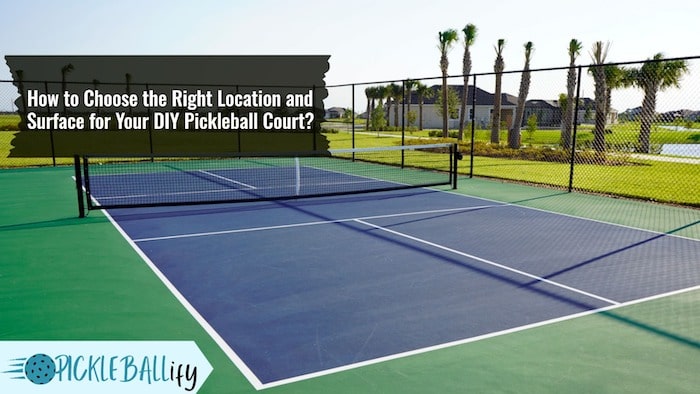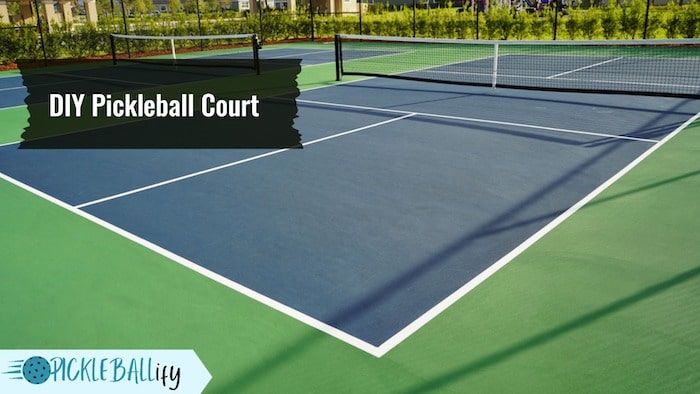Pickleball is a popular sport that is gaining popularity across the world. It’s a combination of badminton, tennis, and ping pong that’s played with a paddle and a plastic ball. While many people like playing pickleball in local parks and recreation centers, having your own pickleball court at home may be an excellent way to improve your game while also having fun with friends and family.

We’ll show you how to choose the best location and surface for your DIY pickleball court, as well as what supplies and equipment you’ll need and how to build it up step by step. So, let’s get started!
How to Choose the Right Location and Surface for Your DIY Pickleball Court
The first step to building your own DIY pickleball court is to choose the right location and surface for it. You want to make sure that you have enough space, safety, and comfort for your pickleball court.
The ideal size for a pickleball court is 20 feet wide by 44 feet long. However, you can adjust the size according to your available space. You also need some extra space around the court for clearance and movement. A minimum of 10 feet on each side and 15 feet on each end is recommended.

The best location for your DIY pickleball court is a flat and level area that is free of obstacles, hazards, and distractions. You want to avoid areas that have trees, poles, wires, rocks, holes, slopes, or uneven surfaces. You also want to consider the direction of the sun, wind, noise, and traffic when choosing your location.
The best surface for your DIY pickleball court is one that is smooth, hard, and durable. You want to avoid surfaces that are soft, slippery, or rough. Some of the common surfaces that you can use for your DIY pickleball court are:
- Concrete: This is the most popular and durable surface for pickleball courts. It provides a consistent bounce and grip for the ball and paddle. However, it can be hard on your joints and feet if you play for long periods of time. You can use an existing concrete slab or pour a new one for your DIY pickleball court.
- Asphalt: This is another common and durable surface for pickleball courts. It is similar to concrete but softer and more flexible. However, it can crack or fade over time due to weather conditions. You can use an existing asphalt driveway or parking lot or lay a new one for your DIY pickleball court.
“Grass surface will not allow the ball to bounce, but driveways or cul-du-sacs can work fine with enough space.” Stated in USAPickleball.
- Acrylic: This is a synthetic surface that is applied over concrete or asphalt. It provides a smooth and colorful finish for your pickleball court. It also reduces the impact on your joints and feet and improves the traction and visibility of the ball and lines.
However, it can be expensive and require professional installation and maintenance. You can hire a contractor or buy a DIY kit to apply acrylic over your existing or new concrete or asphalt surface.
- Modular: This is a portable surface that consists of interlocking tiles that snap together to form a pickleball court. It provides a cushioned and textured surface that is easy to install and remove. It also allows you to customize the size, shape, and color of your pickleball court.
However, it can be costly and require a flat and solid base to support it. You can buy modular tiles online or from a local dealer and assemble them yourself at your desired location.
DIY Pickleball Court
The step to building your own DIY pickleball court is to set it up step by step. Here is a general guide that you can follow for any type of surface:

DIY pickleball court material list:
- Measuring tape
- Marking paint
- Net
- Net posts
- Paddles
- Balls
Step-by-Step Guide to Setting Up Your DIY Pickleball Court
- Clear the area where you want to build your pickleball court. Remove any debris, weeds, or obstacles that may interfere with your court.
- Measure and mark the dimensions of your pickleball court using a measuring tape and marking paint. The court should be 20 feet wide by 44 feet long with a center line dividing it into two equal halves. Each half should have a service line parallel to the net at 15 feet from the center line and a non-volley line parallel to the net at 7 feet from it. The corners of the court should be marked with right angles.
- Install the net posts on each side of the court using either cement or portable bases. The posts should be aligned with the center line and spaced 22 feet apart from each other.
- Attach the net to the posts using hooks or eyelets. The net should be stretched tight across the court and hung 36 inches high at the ends and 34 inches high at the center.
- Check if your surface needs any additional preparation or finishing before playing on it. For example, if you are using concrete or asphalt, you may want to seal or paint it for protection and appearance.
- If you are using acrylic or modular, you may want to follow the manufacturer’s instructions for installation and maintenance. Gather your paddles and balls and enjoy playing pickleball on your DIY pickleball court.
Tips and Tricks to Maintain Your DIY Pickleball Court
Now that you have built your own DIY pickleball court, you want to make sure that you keep it in good condition for a long time. Here are some tips and tricks to maintain your DIY pickleball court:

- Clean your surface regularly by sweeping, vacuuming, or washing it with water and mild soap. Remove any dirt, dust, leaves, or stains that may damage or discolor your surface.
- Repair any cracks, holes, or peeling that may occur on your surface due to weather or wear and tear. Use the appropriate filler, patch, or paint to fix your surface according to the type of material you are using.
- Protect your surface from extreme temperatures, moisture, or sunlight that may cause fading, warping, or cracking. Use a cover, tarp, or shade to shield your surface from the elements when not in use.
- Store your net, posts, paddles, and balls in a dry and cool place when not in use. Avoid leaving them outside or exposing them to rain, snow, or heat that may damage or deform them.
- Inspect your net, posts, paddles, and balls regularly for any signs of wear and tear. Replace any broken or worn-out parts as soon as possible to prevent injuries or accidents.
FAQs
The cost of constructing a pickleball court varies based on a number of factors, including the size of the court, the materials used, and whether you employ a contractor or perform the job yourself. On average, though, you may anticipate to pay anywhere from $3,000 to $10,000 or more.
Again, the time required to create a pickleball court depends on a variety of circumstances. Nevertheless, depending on the size and intricacy of the court, it might take anything from a few days to a few weeks to finish the job.
Yes, you will likely need to obtain permits from your local government to build a pickleball court. The exact requirements can vary depending on where you live, so be sure to check with your local zoning and building departments before you begin your project.
There are a few different surface options for a pickleball court, including asphalt, concrete, and even grass. However, the most popular choice is a specially designed pickleball court surface made of acrylic. This type of surface provides good traction, is easy to maintain, and can last for many years.
Final Words
To summarise, building your own DIY pickleball court may be a fun and rewarding activity for everyone who enjoys the sport. By following the procedures outlined in this guide and using the appropriate materials and equipment, you can build a high-quality court that you will be able to enjoy for many years.
Just remember to plan your project thoroughly, secure all relevant licenses, and seek the assistance of friends or specialists as needed. You can have your very own pickleball court in your own backyard with a little bit of effort and attention. So why not get started right away?

